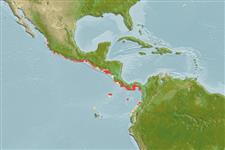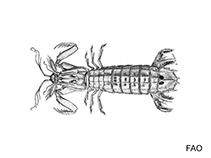Crenatosquilla oculinova (Glassell, 1942)
| Native range | All suitable habitat | Point map | Year 2050 |

|
| This map was computer-generated and has not yet been reviewed. |
| Crenatosquilla oculinova AquaMaps Data sources: GBIF OBIS |
Upload your photos
Google image | No image available for this species;
drawing shows typical species in Squillidae.
Google image | No image available for this species;
drawing shows typical species in Squillidae.
Classification / Names Common names | Synonyms | CoL | ITIS | WoRMS
Malacostraca | Stomatopoda | Squillidae
Environment: milieu / climate zone / depth range / distribution range Ecology
Benthic; depth range 0 - 28 m (Ref. 3613). Tropical
Distribution Countries | FAO areas | Ecosystems | Occurrences | Introductions
Eastern Pacific.
Length at first maturity / Size / Weight / Age
Maturity: Lm ? range ? - ? cm Max length : 4.0 cm TL male/unsexed; (Ref. 3613)
This a benthic species found in muddy and sandy bottoms (Ref. 83920). It inhabits shallow rubble areas (Ref. 3613). Exhibits moderate aggressive behavior in defending its burrows (Ref. 3614).
Life cycle and mating behavior Maturity | Reproduction | Spawning | Eggs | Fecundity | Larvae
Some members of the order Stomatopoda pair for life and some come together only to mate. Males produce sperm ducts rather than spermatophores; females can brood a maximum of 50,000 eggs. Life cycle: Eggs hatch to a planktonic zoea which lasts for 3 months.
Main reference
References | Coordinator | Collaborators
Schiff, H. and R.B. Manning. 1984. (Ref. 3613)
IUCN Red List Status (Ref. 130435)
CITES status (Ref. 108899)
Not Evaluated
CMS (Ref. 116361)
Not Evaluated
Threat to humans
Harmless
Human uses
| FishSource |
Tools
More information
Age/Size
Growth
Length-weight
Length-length
Morphology
Larvae
Abundance
Growth
Length-weight
Length-length
Morphology
Larvae
Abundance
Internet sources
BHL | BOLD Systems | CISTI | DiscoverLife | FAO(Publication : search) | Fishipedia | GenBank (genome, nucleotide) | GloBI | Gomexsi | Google Books | Google Scholar | Google | PubMed | Tree of Life | Wikipedia (Go, Search) | Zoological Record
Estimates based on models
Preferred temperature
(Ref. 115969): 26 - 29.1, mean 28.2 (based on 133 cells).



